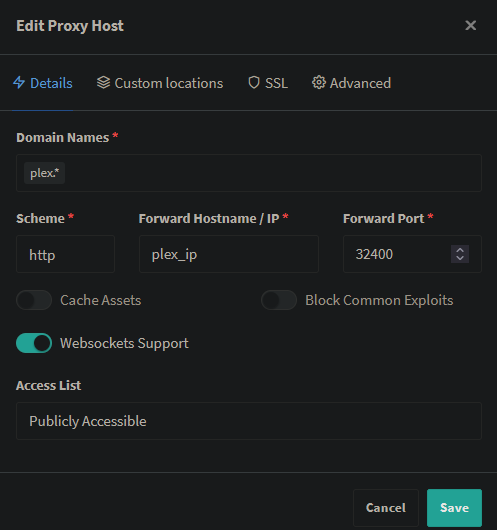I’m to the point now where my little home device has enough services and such that bookmarking them all as http://nas-address:port is annoying me. I’ve got 3 docker stacks going on (I think) and 2 networks on my Synology. What’s the best or easiest way to be able to reach them by e.g. http://pi-hole and such?
I’m running all on a Synology 920+ behind a modem/router from my ISP so everything is on 192.168.1.0/24 subnet, and I’ve got Tailscale on it with it as an exit node if that helps.
You’ll want a reverse proxy like Traefik, Caddy, or nginx in order to get everything onto 80 or 443, and you’ll want to use your pihole to point domains/subdomains to your NAS.
I use nginx proxy manager to reach all my services via servicename.domain.com for example.
https://nginxproxymanager.com/
Nginx proxy manager is really simple to use. Again it runs as a container and uses let’s encrypt certificates.
Ugh. I really gotta switch to this. I started out by using Apache because that’s what I use for work, and just what I know. I create the configs and get the certificates from Let’s Encrypt manually. But now I have so many services that switching to something else feels daunting. But it’s kind of a pain in the ass every time I add something new.
Other than writing an entry in my docker-compose.yml that was all the configuration required. The rest is in the GUI and it’s super simple.
Oh, I don’t have a GUI for my server. But I’m sure they have a command line interface for it, right?
I mean nginx proxy manager is managed by a GUI/web interface.
Oh right a web interface. That makes more sense. 😅
Yeah, I really do need to get around to setting that up…
You need a reverse proxy. That’s what they do.
The next thing is fully subjective, but I would not recommend Nginx Proxy Manager. It has a neat GUI, but in my setups it has been failing often times, especially if used in public servers with letsencrypt certificates.
Maybe I fucked up something, but I can really recommend caddy instead. It’s configured from a yaml file, but I find that to be much more flexible for custom rules and so on. Also, configuring caddy is stupidly simple, I love it.
The way I got it set up using Pihole and NginxProxyManager in Unraid:
- Deploy NginxProxyManager using custom: br0 with a separate IP address

- Pihole can’t do wildcards unless you create
pihole/dnmasq.d/03-custom-dns.confand addaddress=/tld/npm_ip, this way *.tld goes to the stated IP.

- Now your plex.tld goes to your nginx proxy manager IP, and it needs to handle the subdomain.
NginxProxyManager can do wildcards both ways, so you can create
plex.*to go to plex IP and port. orsonarr.*that goes to your server IP and sonarr port

Please tell me if you need more details.
Thanks to everyone who replied, but I gave up on this. Turns out that Synology’s DSM has nginx as part of it, without exposing it as configurable, that commandeers ports 443 and 5000, and any other port seems to direct to 5001(?) which is the desktop manager login. I’ll just remember all the ports or maybe get Heimdall spun up!
Everybody is saying a reverse proxy which is correct, but you said docker stacks, so if that means docker compose then the names of your container is also in DNS so you can use that.
Can’t remember if port is needed still or not however.
There’s a few options. Personally I use nginx. You can build a proxy container running nginx, then you can direct traffic to other containers.
I do things like
serviceX.my.domainand that will know to proxy traffic to serviceX. Added benefit is that now you have one ingress to your containers, you don’t need to memorize all of those ports.I know traefik is a thing that other people like
If you want something real simple you could also do Heimdall, which let’s you register your systems you have running, you open Heimdall first and it’ll direct you to what you have running, but that’s essentially just fancy bookmarks
I looked at Heimdall and came to the same conclusion, I could just whip up a static html page of links, or make bookmarks, easier than maintaining another docker.
Yep, tried it and yeah just a fancy page for bookmarks - although it did make a nice home/landing page for me whenever I opened a new tab.
Nginx is your friend then, set up a good proxy and it’ll be much easier to navigate your network.
Acronyms, initialisms, abbreviations, contractions, and other phrases which expand to something larger, that I’ve seen in this thread:
Fewer Letters More Letters DNS Domain Name Service/System HTTP Hypertext Transfer Protocol, the Web IP Internet Protocol NAS Network-Attached Storage SSL Secure Sockets Layer, for transparent encryption TCP Transmission Control Protocol, most often over IP UDP User Datagram Protocol, for real-time communications nginx Popular HTTP server
[Thread #288 for this sub, first seen 18th Nov 2023, 19:15] [FAQ] [Full list] [Contact] [Source code]




